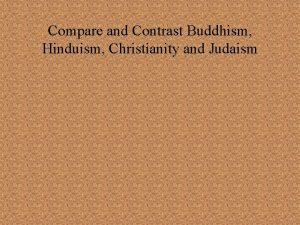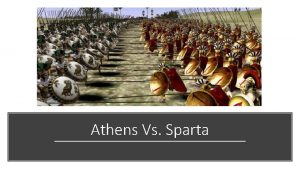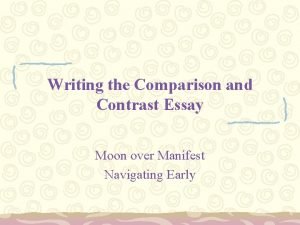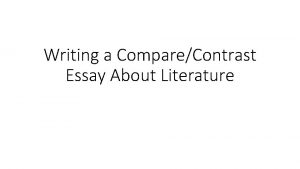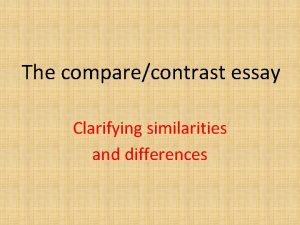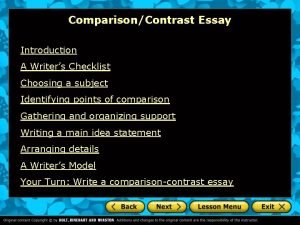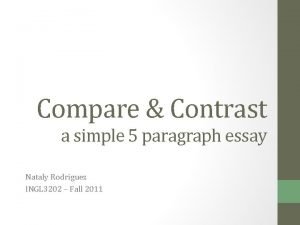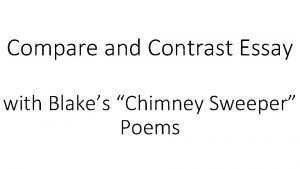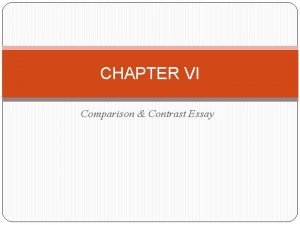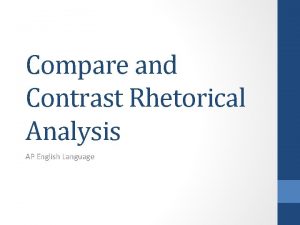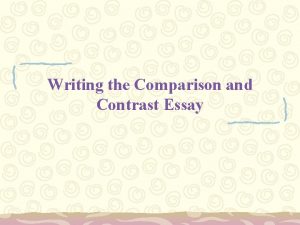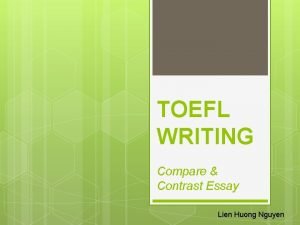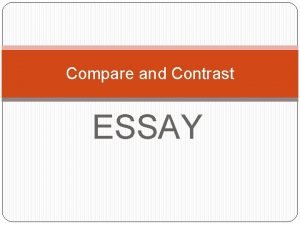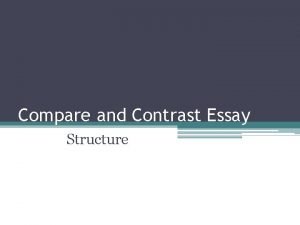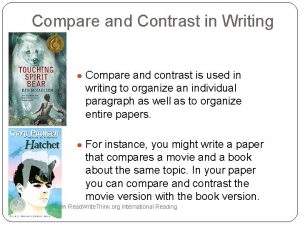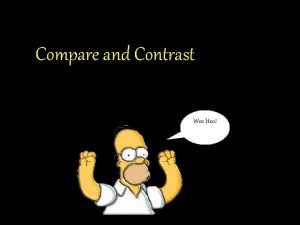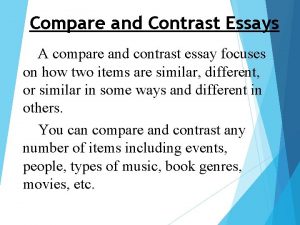COMPARE AND CONTRAST ESSAY WRITING PURPOSE To reveal












- Slides: 12

COMPARE AND CONTRAST ESSAY WRITING

PURPOSE: To reveal similarities and/or differences between two subjects or things. Compare contrast essays are used to examine two or more subjects and the similarities and/or differences between them. The task of this type of essay is to clarify something unknown by analyzing it next to something with which the reader is familiar. It is important that your thesis statement clearly states whether you will be comparing, contrasting, or sometimes, both. Be sure your thesis gives a sneak “peek” into the points you make in your paper. The thesis is your opinion and can be argued because you chose those 2 or more points of comparison or contrast to explore in your essay. In other words, someone else could disagree with your claim that those are the main or most important points to mention in your essay, so you need to use evidence to support your points compared or contrasted.

Key Prompt words Compare Contrast Show differences Show similarities Differentiate Show a connection between Common

Most important aspects of Compare/Contrast Writing: KNOW WHETHER TO COMPARE OR CONTRAST (or both) Must be able to interpret the essay prompt to know what it is asking of you Must show a clear line of differences or similarities Must provide specific logical evidence to prove the similarities or differences BEYOND THE OBVIOUS: It is important that you go beyond the obvious to compare and contrast; your essay should be enlightening and effective, not merely a summary or description of items.

EXAMPLES OF COMPARE AND CONTRAST PROMPTS The theme of revenge is common in many of Shakespeare’s plays. Explore theme of revenge, and consider how it is treated in two of Shakespeare’s plays. There is a saying: “The more things change, the more they stay the same. ” Find the similarities between life when you were in kindergarten and your life today. Using the two texts being studied in class, contrast how differently each of the protagonists are treated by their families and society in general.

Remember in a Compare/Contrast paper, you are to show the MAJOR similarities and/or differences between a subject/s. Your thesis statement must clearly state whether you will be comparing, contrasting, or both. Example of a simple Prompt: Compare and contrast entering junior high and high school. Simple Compare/Contrast Thesis: While there are several similarities between entering junior high and high school, the differences are stark and even shocking for some students.

TESTING THESIS: Does this thesis qualify as a Compare/Contrast thesis? BASIC IS THES Simple Compare/Contrast Thesis: While there are several similarities between entering junior high and high school, the differences are stark and even shocking for some students. 1. Does thesis address whether the essay will cover similarities, differences, or both? 2. Does thesis mention the topic of the essay? 3. Does thesis tell what points will be compared/contrasted? Better Thesis Statement for the Topic: BETTER THESIS While both junior high and high school begin with new faces and lost students looking for their classroom, the shock of being a small fish in a big pond and the overwhelming feeling of drowning in homework is common as one enters the intimidating world of high school.

VERBAL CUES: The keys to the Compare/Contrast Essay Consider the following passages: There are many differences between a good student and a bad student. Good students study, and bad students may cram the night before. Bad students turn in their work only once in a while and good students do their homework. There are many differences between a good student and a bad student. Good students study, while bad students cram the night before. Good students do their homework, unlike bad students, who turn in their work only once in a while. Do you see the differences between these two passages? The first uses the word “and” as the transition and the second one uses more effective transition words (bridges) to emphasize the differences between good and bad students.

SOME EFFECTIVE COMPARE/CONTRAST TRANSITION WORDS OR BRIDGES (Refer to the ELA Survival Guide (Transition words at a Glance) under Compare/Contrast CONTRASTING COMPARING alike too along the same lines similarly also likewise as well like as well as is similar to in the same way compared to by the same token in comparison to in the same manner both but while by contrast yet contrasted with whether or not contrasting unlike conversely rather than however on the other hand in contrast on the contrary in spite of nonetheless nevertheless By using these bridges, the reader gets a cue to indicate that a difference or similarity is coming. Be care though, do not use transition words everywhere, just where you need them. Overuse of these words can create confusion for the reader, and make the essay less effective.

ESSAY METHODS FOR COMPARE/CONTRAST POINT BY POINT METHOD Let’s say the topic is PC and Mac personal computer systems, and thesis is that the discriminating consumer should buy a Mac. You may choose to discuss the comparisons and contrasts of each main idea point by point, paragraph by paragraph: maybe software, ease of use, and cost. In doing so, create a mini-essay in each paragraph: ¸ Each paragraph should have a topic sentence that indicates the main ideas of the paragraph. For instance, “Mac software is more creative and has more applications. ” Each paragraph should contain some cursory comparisons ¸ Each paragraph should then have the contrasts that prove the point of your topic sentence (and, as a result, your thesis). BLOCK METHOD In the block method, each paragraph addresses ONE TOPIC ONLY from your topics selected and includes SHARED ASPECTS you have chosen to compare OR contrast as stated in the topic sentence This organizational pattern is most effective when used on short essays, such as in-class essays. The body of such an essay is organized by discussing one subject, point by point, in complete detail before moving on to the next subject. The writer should select points by which both subjects can be examined. The number of body paragraphs will be determined by the number of points discussed in the essay.

SAME TOPIC: EXAMPLES OF BLOCK VS. POINT BY POINT BLOCK EXAMPLE Students who have Mr. Jones and Mr. Smith are immediately aware of the difference in the lecturing manner of each teacher. Mr. Jones has a pleasant voice, which helps hold the interest of the students. He pronounces clearly in a rhythmic pattern emphasizing key words. His moderate tone and inflected words make his lectures interesting. Mr. Jones also adds humor to his subject, and he welcomes questions from students who do not understand the material. He takes his time and explains slowly. He tries to make sure that his students understand a concept before he moves on to something new, and he is very enthusiastic about his subject. Mr. Smith, on the other hand, has a different tone, pronunciation, expression and attitude from Mr. Jones. He has a booming voice, which commands rather than teaches, and sometimes it is hard to understand because he runs his words together. His lectures are not as interesting as those of Mr. Jones, either, because Mr. Smith speaks in a boring monotone. He also hates to be interrupted; feeling that he must cover everything without checking for understanding among students. Mr. Smith teaches every class in a serious, determined mood. Thus, as the above points illustrate, the lectures of both teachers are quite dissimilar.

SAME TOPIC: EXAMPLES OF BLOCK VS. POINT BY POINT-BY-POINT EXAMPLE Students who have Mr. Smith and Mr. Jones are immediately aware of the difference in the lecturing manner of each teacher. Mr. Jones has a pleasant voice, which helps hold the interest of the students. Mr. Smith, however, has a booming voice, which commands rather than teaches. Mr. Jones pronounces clearly in a rhythmic pattern emphasizing key words. On the other hand, Mr. Smith mumbles, running his words together. The moderate tone and inflected words of Mr. Jones make his lectures more interesting than those of Mr. Smith, who speaks in a boring monotone. Mr. Jones also adds humor to the subject, whereas Mr. Smith is always serious about each lesson. Mr. Jones welcomes questions from students who do not understand the material, as compared to Mr. Smith who hates to be interrupted. Mr. Jones takes his time and explains slowly, while Mr. Smith rushes through each lesson. Mr. Jones is very enthusiastic about his subject; he tries to make sure everyone understands a concept before he moves on to something new. Conversely, Mr. Smith is always in a determined mood; he feels that he must cover everything without stopping. Clearly, each teacher has an dissimilar approach to presenting information including their tone, voice, and attitude about the subject matter they are presenting to students.
 Hinduism and judaism compare and contrast essay
Hinduism and judaism compare and contrast essay Similarities
Similarities Title for compare and contrast essay
Title for compare and contrast essay Point-by-point essay examples
Point-by-point essay examples Definition of compare and contrast essay
Definition of compare and contrast essay Harry potter poem
Harry potter poem Compare and contrast essay checklist
Compare and contrast essay checklist 5 paragraph compare and contrast essay
5 paragraph compare and contrast essay Compare and contrast essay outline
Compare and contrast essay outline Compare and contrast signal words
Compare and contrast signal words Ap lang compare and contrast essay
Ap lang compare and contrast essay Alternating compare and contrast essay
Alternating compare and contrast essay Compare and contrast essay toefl
Compare and contrast essay toefl
